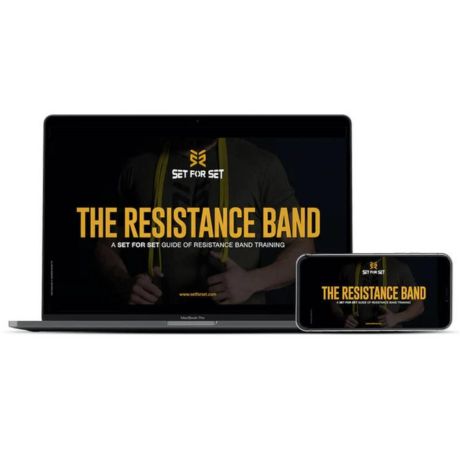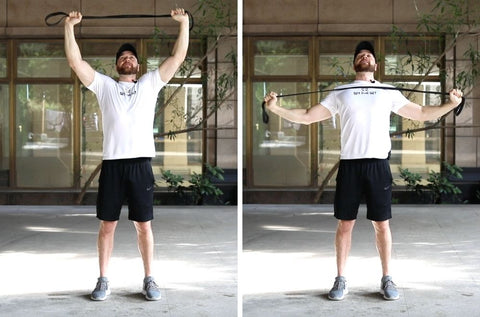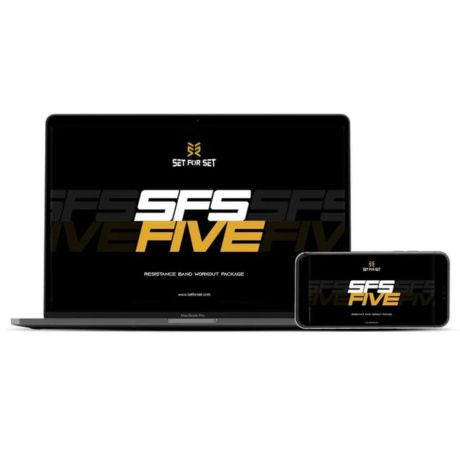While free weights are undoubtedly the best for building muscle mass and strength, resistance bands are a great way to keep your muscles guessing. By doing resistance band back workouts or simply mixing resistance band back exercises into your weight training you can avoid stagnation and plateaus. Resistance bands will target your back muscles with elastic tension, which is a much different muscle stimulation than gravitational resistance from free weights.
But resistance bands are not just great for switching things up and tricking your body into more growth and improvements, they are also highly effective for people who want to train with less stress on their joints. If you have joint issues, you can completely forgo free weights and only use bands.
Furthermore, resistance bands are good for people who want to work out from home without investing a lot of money into heavy equipment. With loop resistance bands, you can get an effective back workout in anywhere you wish. And if you know how to use resistance bands in all the various ways, you don’t even need an anchor to tie the bands up to for back exercises.

Our guide has over 250 exercises categorized by mobility, mobilization, resistance training, barbell training, explosive training, static stretching, and (p)rehabilitation...
Below, we will discuss how you can use loop resistance bands to successfully target your back muscles - lats, upper back, traps rhomboids, teres major/minor, low back, etc. We also have 8 resistance band back exercises (without the need of an anchor or attachment) that we run through and then a full length, follow along metabolic resistance band back workout that will get your back and biceps pumped like crazy.
8 RESISTANCE BAND BACK EXERCISES
HOW TO TARGET BACK MUSCLES WITH RESISTANCE BANDS
Let’s go over each of the back exercises from the video above to discuss what muscles they target.
1. Single Arm Row

Muscles Targeted: The primary mover here is the latissimus dorsi. So that is the main muscle you are targeting. However, you will also be engaging your entire back with this one, which includes your trapezius, rhomboids, teres major and minor, deltoids, infraspinatus, biceps, brachialis, brachioradialis, and even pecs. Moreover, as it is a single arm movement, your core and low back will be working to stabilize you.
Tips:
- Concentrate on pulling with your back muscle right behind and below your shoulder (lats).
- Keep your abs pulled in tight at all times and don’t sag your back or hunch up.
- Pull your shoulder down and back to set and stabilize your shoulder blades.
- If the movement is too easy, being with the band more taut by wrapping it around your foot more and looping your hands threw it a couple times.
2. Bent Over Rows

Muscles Targeted: Bent over rows are one of the best back exercises you can do as they target many muscles at once. The main muscle groups being worked are the lats, rhomboids, erector spinae, and traps. You will also be indirectly working your biceps, forearms, triceps, rear delts, hamstrings, glutes and core.
Tips:
- Make sure you maintain the high hip hinge as you row.
- Keep your core engaged.
- Maintain alignment at all times.
- Protract your shoulder blades at the bottom.
- Pull to your belly button.
- Hold at peak contraction and then slow negative movement.
Related: 17 Resistance Band Row Variations
3. Deadlift

Muscles Targeted: The Deadlift is the king of the posterior chain. It works all your muscles from your hamstrings up to your traps. We like to do deadlifts on back day so we can focus heavily on squat movements on leg days.
Tips:
- Never arch your back. Hinge your hips during the lower portion of the movement.
- We like to explode up and move slowly down with bands. The eccentric phase will really give you some good strength gains.
- Straight your lower back at the top and retract your shoulder blades to really contract all your back muscles.
- Keep your chest up at all times.
Related: 4 Resistance Band Deadlift Variations
4. Lat Pull Down

Muscles Targeted: This is lat focused exercise that will also target your rear delts. This is a posture improving exercise and a v-shape muscle builder.
Tips:
- With bands, it can be difficult to make this exercise effective. You really need to keep that mind-muscle connection in check. Focus on your lats and really squeeze them on the way down and keep them tight and contracted on the way back up.
- As with all back exercises, your shoulder blades play an important role. Be sure to retract your shoulder blades as you pull down. Squeeze them together, down and back, at an almost diagonal angle. Learn more about scapular stabilization, this will help you understand how your shoulder blades stabilize during back movements, which will make your resistance band back exercises more effective.
5. Seated Row

Muscles Targeted: Traps (lower), latissimus dorsi, rhomboids, rear delts and biceps. It will also work your erector spinae, as you need your lower back to stabilize your movement. Overall, this is a great movement for your mid-back.
Tips:
- Sit upright. Slightly leaning back is ok.
- Retract your shoulder blades as you pull the band back.
- It’s ok to protract the shoulder blades to get more of a stretch during the eccentric phase (when you are bringing the band back towards your feet).
- Keep your core fully engaged, which means your low back too!
- Row towards just above your navel.
6. Stiff-Legged Deadlift

Muscles Targeted: Although this movement is generally associated with leg workouts, we added it to our banded back workout as it works the posterior chain and that was our focus of the day. Anyway, it will hit your hamstrings, erector spinae, and glutes, as well as your forearms, lats and traps a bit.
Tips:
- Keep a slight bend in your knees at all times.
- Be sure to hinge your hips so your don’t hunch your back during the movement.
- As you reach the top, pull your shoulder blades back and stop when your spine is straight. Really engage the back muscles like this.
- Slow negatives are really the best for stiff legged deadlifts.
7. Reverse Fly

Muscles Targeted: This is a movement that can be done on shoulder day as it targets the rear delts. However, we like to also hit it on back day as the rear delts often need double the work each week. The reverse fly with bands will work your rhomboids, rear delts and traps. It’s a great upper back exercise.
Tips:
- Focus on really contracting your upper back muscles. Squeeze and hold once you reach the peak contraction, then slowly return to the starting position.
- Keep your core engaged throughout each set.
- Try to keep your elbows up so you can target your upper back muscles correctly.
8. Trap Raises

Muscles Targeted: This is another exercise that can be done on shoulder day, but we often hit trap raises on back day too as it is a muscle that can handle more volume per week. This exercise will target your traps and forearms. If you want wrestler type traps, hit this one. It is super effective with bands.
Tips:
- Squeeze and hold at the top for a second or two.
- Keep your shoulder blades retracted.
- Aim your elbows up and back as you raise up. This will help your target the traps better.
How to target your lats with resistance bands?
The best resistance band exercises for the lats are:
How to target your upper back with resistance bands?
The best resistance band exercises for the upper back are:
How to target your mid back with resistance bands?
The best resistance band exercises for the mid back are:
How to target your lower back with resistance bands?
The best resistance band exercises for the lower back are:

ARE RESISTANCE BANDS EFFECTIVE FOR BACK WORKOUTS & EXERCISES?
If used correctly, resistance bands can be highly effective for back exercises. Due to the nature of elastic tension, you will not be doing jerky motions like people sometimes do with free weights. This means you will have constant tension on your muscles during a resistance band exercise. You can move slowly through both the concentric and eccentric phase of the movement. Conversely, you can be explosive on the concentric phase of the movement, but you should always move slowly and very controlled on the eccentric phase (a.k.a. the negative) or else you will lose the tension.
So, by focusing on providing your back muscles with maximum contraction and time under tension, you can surely get a great back workout in with just resistance bands.
In terms of building muscle, the science is simple. You need adequate tension, recovery, and then progressively overload your muscles each week. So, as long as you are providing your muscles with enough tension (or time under tension) and then you recover properly and during the next workout you make it a little more challenging than the last, you will be able to build muscle over time. However, for progressive overload, you really need to keep consistency with your workouts, which includes the implements you are using. For those that use other implements, bands are more of a way to shock your muscles, and to target them in a different way. Bands work really well for hitting deep into the tissue, better than doing high reps with free weights in our opinion. This is how you build solid, lean muscle.
Here’s how you can build muscle with resistance bands
All in all, we know resistance bands are effective for back workouts because we do them all the time and the banded workouts we create are brutal. The resistance band workout below is going to get you sweating up a storm and your back and biceps are going to be blasted to the point where they feel like they are going to explode.
At SET FOR SET, we also train with other implements like steel maces, barbells, kettlebells, and so on. That way, when we sneak a resistance band workout in, we shock the muscles…again and again, as it works like a charm every time.

BENEFITS OF USING RESISTANCE BANDS FOR BACK WORKOUTS?
- Get a back workout in anywhere at any time.
- Shock your muscles in a different way.
- One resistance band can provide various levels of resistance depending on how far you stretch them or how taut you make the band from the start of the movement.
- Bands are less taxing on your joints, especially the spine.
- You can target your back from different angles as bands use elastic tension rather than gravitational force, so the tension can be produced from any direction.
- They are great to use in tandem with free weights, either as supersets or combined into lifts like banded barbell deadlifts.
Top 7 Benefits of Resistance Bands

HOW DO YOU STRENGTHEN YOUR BACK WITH RESISTANCE BANDS?
If you want to strengthen your back and build muscle with resistance bands, you need to expose your muscles to a lot of time under tension. The more time under tension and the more you focus on muscle contraction, the more intense the exercise is, which means you will get stronger and build muscle over time.
Time under tension can be managed in two ways, longer sets and less rest time. At SET FOR SET, we like to employ both tactics. Sets of 45-60 seconds with rest time of around 30 seconds. A resistance band back workout with a 2:1 work-rest ratio is great. You will get a lot of time under tension in a short time. It will really dig deep into your muscles and stress them enough for strength and muscle gains.
BACK MUSCLE ANATOMY
Let’s go over the anatomy of the back muscles so we can be clear on what muscles we are targeting with the exercises below.

We are just going to focus on the main superficial back muscles, as those are the visible muscles and ones associated with back workouts.
Trapezius: The broad, flat, triangular muscle originates at the skull and spans down to our mid spine and to the side of our shoulder joints. It’s a large muscle and one of the most superficial of the back. If you want a great looking back, you need to hit your traps effectively!
Related: Best Trapezius Exercises With Weights
Latissimus Dorsi: This is the largest and broadest muscle group of the back. The wide back muscles originate at the spine, wrapping around our body and inserting at the biceps, lower ribs and lower spine. For that v-shape back that we all strive for, hitting the lats is a must.
Related: Best Latissimus Dorsi Exercises
Rhomboids: The rhomboids are made up of two muscles, the rhomboid minor and major. They act to rotate the scapula. Your rhomboids attach to the spine and medial border of the scapula. It’s one of the most overlooked muscles when discussing back workouts, but crucial nevertheless. You really need to develop a good mind muscle connection to target your rhomboids as the traps can take over if you aren’t really honing in properly.
Related: Best Rhomboid Exercises for a Stronger More Defined Back
Erector Spinae: The erector spinae runs from the bottom of your spine all the way up to your neck. We won’t go into too much detail as you can read all about the erector spinea here. Let’s just call this the low back for now. Low back is part of your core, as is your erector spinae. Training your low back is vital to having a strong back, core, and legs.
Teres Major & Minor: The teres major and minor run along the lateral border of your shoulder blades. You can learn more about the teres major and minor here.
Glutes: A lot of back exercises incorporate the glutes, so we are adding this one in. A strong back means strong glutes. It’s part of your posterior chain. Many of the resistance band exercises we will do involve the glutes.
30 MINUTE RESISTANCE BAND BACK WORKOUT
Here is a full length resistance band workout that you can follow along to at home. It’s going to really kick your butt. You are guaranteed to sweat like crazy as you blast your back with tons of time under tension in a short duration. If you are looking for a calorie-burning, muscle-building efficient back workout, this is the one.
NOTE: Sorry about the audio. We had a microphone slip up!
EQUIPMENT: Set of 3 resistance bands
**No Anchor Needed - you won't have to attach the bands to anything so you can do this resistance band back workout anywhere!**
The resistance band exercises within each mini workout will target your lats, traps, rhomboids, rear delts, lower back, erector spinae, mid back, trees major/minor, biceps and forearms.
RESISTANCE BAND BACK WORKOUT:
This power resistance band back metabolic workout consists of 3 mini workouts:
- 5 Minute AMRAP
- 6 Minute EMOM
- 6 Minute Circuit
3 MINI WORKOUTS & EXERCISES:
5 Min AMRAP:
- Single Arm Row L/R x 10 each side
- Stiff-Legged Deadlifts x 15 reps
- Band Pull Aparts x 12 reps
6 Min EMOM
- Deadlifts x 15 reps
- Bent Over Row x 15 reps
Circuit: 3 rounds x 12 reps (20 seconds rest between sets/rounds)
- Seated Rows
- Band Pull Downs
- Bent over back fly or Band Back Fly - Lying

The SFS FIVE Resistance Band Workout Package has 5 fun and challenging full length workouts using only resistance bands. Each workout targets different muscle groups. Together, the 5 workouts make for the perfect weekly workout routine.
Summary:
Resistance bands should be a tool in every fitness enthusiast's arsenal. Even the biggest, strongest, most professional male and female trainees use resistance bands to great effect.
If you want to break plateaus, continue shocking your muscles in new ways, workout from home, or train in a way that is less taxing on your joints, get yourself a set of resistance bands now…
Resistance Bands by SET FOR SET
More targeted resistance band exercises:
- Resistance Band Shoulder Exercises
- Resistance Band Chest Exercises
- Resistance Band Bicep Exercises
- Resistance Band Leg Exercises
- Resistance Band Tricep Exercises
- Resistance Band Core Exercises
- 24 Best Resistance Band Exercises













Sam Coleman
Author